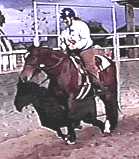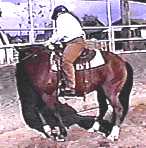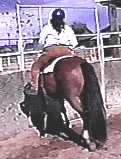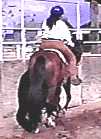|
Rollbacks (also called roll-aways) are turns over the haunches. The horse plants
his weight over his hind feet and pivots around using his front legs. Rollbacks are
useful to teach horses to stop, to get them to get off the forehand and balance
themselves from the rear, and if you ever turn around on a narrow cliffside mountain trail, it may be
critical that you be able to make a U-turn without your horse's hind end swinging
off the edge of the trail.
|
Patty sets CJ up alongside a fence. The fence will help keep CJ from stepping forward when executing the
roll, and should encourage him to shift his weight back over his hindquarters in order not to bump
the fence.
Patty tells CJ to "whoa", then takes up both reins and as soon as he shifts his weight backwards,
she "opens up" the right side by drawing his head to the right, while at the same time keeping just
enough pressure on the left rein to keep CJ from bending his neck and breaking loose in behind and stepping out
with his hind legs. She also looks in the direction of the turn.
Patty supports the roll by tap-tap-tapping with her left leg at the cinch line "pushing" CJ's
front end into the turn. At this point the primary aid is Patty's left leg. If she draws too hard
with the rein, CJ's entire body will bend and he will fall out of the roll. He should bend his
neck just enough to clear the fence. Ideally, he should eventually rock back far enough so that he can
perform the roll without bending his neck at all.
| >


|
 Patty continues the roll by tap-tap-taping CJ with her left leg. Notice how CJ's body stays
straight as he swings past the fence and his hind feet remain virtually in the same spot.
Patty continues the roll by tap-tap-taping CJ with her left leg. Notice how CJ's body stays
straight as he swings past the fence and his hind feet remain virtually in the same spot.
 As CJ starts to complete the roll, Patty balances out her contact on the reins so that he
will step forward and walk off in a straight line. The reins have to be "given back" as she
comes to the end of the roll, else CJ will tend to "oversteer".
As CJ starts to complete the roll, Patty balances out her contact on the reins so that he
will step forward and walk off in a straight line. The reins have to be "given back" as she
comes to the end of the roll, else CJ will tend to "oversteer".
Both the disengagements and rollbacks need to be developed equally in both directions.
Press "Back" to return to the page that brought you here
KBR Horse Training Information, © 1997
Lamm's Kickin' Back Ranch and Willis & Sharon Lamm. All rights reserved. Duplication of any of
this material for commercial use is prohibited without express written permission.
This prohibition is not intended to extend to personal non-commercial use, including sharing
with others for safety and learning purposes, provided this copyright notice is
attached.
Email us to submit comments or
request reproduction permission.
|

 As CJ starts to complete the roll, Patty balances out her contact on the reins so that he
will step forward and walk off in a straight line. The reins have to be "given back" as she
comes to the end of the roll, else CJ will tend to "oversteer".
As CJ starts to complete the roll, Patty balances out her contact on the reins so that he
will step forward and walk off in a straight line. The reins have to be "given back" as she
comes to the end of the roll, else CJ will tend to "oversteer".


 Patty continues the roll by tap-tap-taping CJ with her left leg. Notice how CJ's body stays
straight as he swings past the fence and his hind feet remain virtually in the same spot.
Patty continues the roll by tap-tap-taping CJ with her left leg. Notice how CJ's body stays
straight as he swings past the fence and his hind feet remain virtually in the same spot.